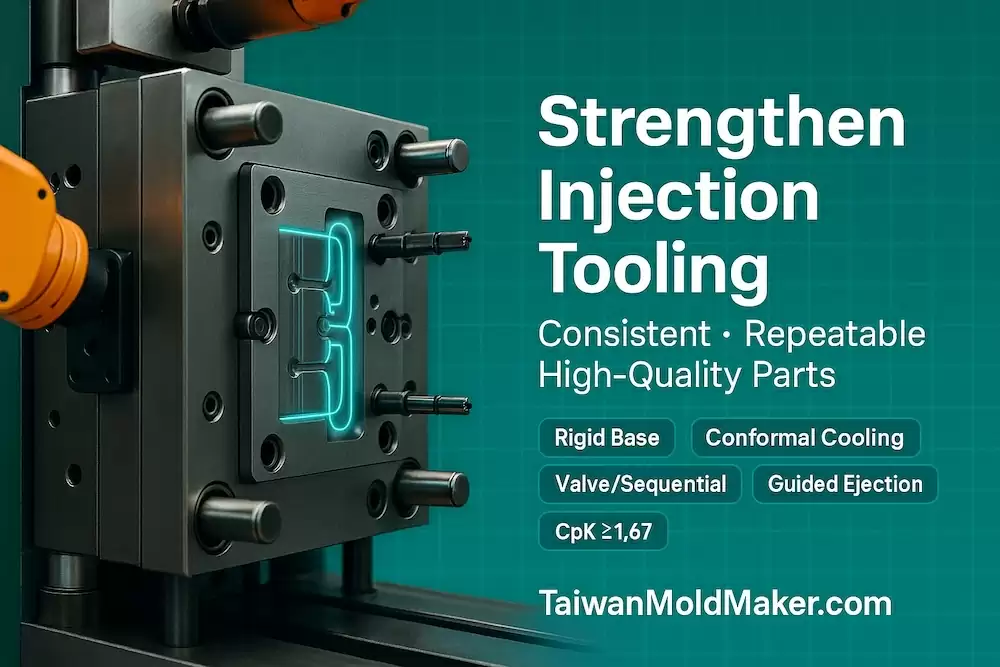Strengthen Injection Tooling for Consistent, Repeatable High-Quality Parts
Strengthen Injection Tooling for Consistent, Repeatable High-Quality Parts

Strengthen Injection Tooling for Consistent, Repeatable High-Quality Parts
Repeatability isn’t luck—it’s built into the tooling. By engineering rigidity, thermal balance, wear protection, and clean ejection into the mold from Day 1, you lock a wider process window, faster cycles, and CpK ≥ 1.67 at CTQs. The TaiwanMoldMaker.com partner network co-designs tools and press cells so you can ship the same part, every shot.
What “Strengthened Tooling” Really Means
-
Rigidity & alignment: thick plates, rigid platens, precision leader pins/bushings, guided ejection.
-
Thermal control: balanced circuits, conformal cooling at hotspots, ΔT ≤ 5 °C across circuits.
-
Gate discipline: balanced runners, valve/sequence timing, minimized shear & blush.
-
Wear & life: steel where it counts (H13/S136/M2), protective coatings (TiN/DLC), hardened shut-offs.
-
Clean air & flow: smart venting and vacuum-assist on thin walls/optics.
-
Maintainability: standard components, sensors, quick-change inserts, service access.
-
Evidence: cavity pressure + temperature instrumentation, SPC hooks, MES history.
Failure Mode → Tooling Fix (Quick Guide)
| Symptom | Likely Root | Strengthen the Tool With |
|---|---|---|
| Warp / out-of-flat | Uneven cooling, fiber bias | Conformal cooling, parallel circuits, symmetric gates; balance pack/hold |
| Sink at bosses/ribs | Local mass, starved pack | Core heavy bosses; ribs at 40–60% wall; larger gate/shorter land; local high-κ inserts |
| Weld-line weakness | Late flow front, low temp | Fan/film gates, higher mold temp or RHCM, sequential valves to move welds |
| Gate blush / gloss halo | Excess shear at gate | Increase gate area; hot tip tuning; move to fan/edge gate; raise mold temp |
| Flash | Deflected plates, worn shut-offs | Thicker plates, support pillars, tapered shut-offs, harder steel + re-fit |
| Short shots | Fill pressure drop | Natural balance in runners, larger gate, venting upgrade, hotter melt/mold |
| Scratches / eject marks | Poor ejection load path | Guided ejector, more pins, stripper plate, draft ↑, texture class alignment |
Build It Right: Tooling Levers That Pay Back
-
Mold Base & Rigidity
-
Stiffen with thicker A/B plates and support pillars under high load zones.
-
Use precision leader pins/bushings; consider interlocks on large molds.
-
-
Steel & Coatings
-
Gate edges, lifters, slides: H13/S136 or wear steels; coat with TiN/DLC for glass-filled resins.
-
Optical zones: high-polish corrosion-resistant steel (S136).
-
-
Cooling Architecture
-
Channel Ø sized for Reynolds > 4,000; depth ~1–1.5× Ø; pitch 2–3× Ø.
-
Add conformal cooling or high-conductivity inserts where ΔT mapping shows hotspots.
-
-
Gating & Hot Runners
-
Natural balance first; engineered balance if layout demands.
-
Valve gates for cosmetics and multi-cavity; sequential on long skins to move welds.
-
-
Venting / Vacuum
-
Vent depth to resin spec; add micro-vents at knit lines; vacuum assist for thin-wall fills.
-
-
Ejection System
-
Guided ejectors; distributed pins near ribs/bosses; stripper plates for fragile rims; air-assist as needed.
-
-
Sensors & Data
-
At least one cavity with cavity-pressure and near-wall thermocouples.
-
Gate thermocouple or freeze-time proxy; tie to V/P transfer.
-
-
Maintainability & SMED
-
Standardize components, put wear items on inserts, quick water/electric couplers, labeled manifolds.
-
Capability & Cosmetic Acceptance Targets
| Category | Typical Target |
|---|---|
| Dimensional CpK at CTQs | ≥ 1.67 (launch), ≥ 2.00 (steady state) |
| Warp/flatness | Per drawing; use fixtures for rapid GR&R |
| Color ΔE / Gloss | ΔE ≤ 1.0–1.5 (brand dependent); gloss within spec window |
| Gate vestige / flash | Non-detectable at 50 cm; flash ≤ 0.05 mm |
| Scrap rate | ≤ 1.0% in control plan (consumer); tighter for regulated |
Preventive Maintenance That Protects Repeatability
-
Every shift: clean vents/gates, check clamp force, verify recipe hash.
-
Weekly: pull strainers, descale water lines, borescope hot runner channels.
-
Lotly: verify cavity pressure curves vs. golden signature; inspect shut-offs under scope.
-
Quarterly: flow-test cooling circuits, leak-check valves, re-lap high-risk shut-offs.
From DFM to SOP: How We Strengthen Your Tool
-
48-Hour DFM Pack: gating/cooling map, risk register, cycle model.
-
CAE review: fill/pack/cool + ΔT plan; weld-line and pressure maps.
-
Tool kick-off: steel callouts, coatings, sensor plan, spare insert set.
-
Trials (T0/T1/T2): scientific DOE; cavity-pressure signatures → golden recipe.
-
Qualification: FAIR, CMM/scan, GR&R, cosmetics buy-off; CpK at CTQs.
-
SOP: MES guardrails, PM schedule, spare kit, and training hand-off.
RFQ Template (Copy/Paste)
Subject: RFQ – Strengthened Injection Tooling for High-Repeatability
Attachments: STEP/IGES + 2D drawings with CTQs & cosmetic map
-
Part name / revision:
-
Annual volume & first PO qty:
-
Resin & additives: (GF %, FR/UV, color, MFR)
-
Cosmetic class & texture (SPI code, ΔE target):
-
Pain points to eliminate: (warp, sink, weld line, blush, flash, eject marks)
-
Preferred gating: (edge/fan/valve/sequential) & keep-outs
-
Cooling constraints: (press water temp/pressure; oil circuit needs)
-
Instrumentation & quality pack: (cavity pressure, thermocouples, FAIR, CMM, CpK)
-
Logistics: (dual-plant, call-offs, labels)
-
Target dates: (T1, buy-off, PPAP/SOP)
Related Services & Quick Links
-
Custom Mold & Design Maker – DFM, CAE, steel & cooling strategy
https://www.taiwanmoldmaker.com/product/custom-mold -
Mold Service – aluminum, hybrid, and full-steel tooling
https://www.taiwanmoldmaker.com/product/mold-service -
Injection Mold – materials & processes overview
https://www.taiwanmoldmaker.com/product/injection-mold -
Molding – automated cells with MES & vision SPC
https://www.taiwanmoldmaker.com/product/molding -
Customer Examples – case snapshots and results
https://www.taiwanmoldmaker.com/product/customer-examples
Call to Action
Ready to stabilize yield and cosmetics with stronger tooling? Send your CAD and CTQs to get a 48-Hour DFM & Cost Pack—including a cooling plan, gating strategy, sensor layout, and cycle model.
Request an Instant Quote → https://www.taiwanmoldmaker.com/contact








